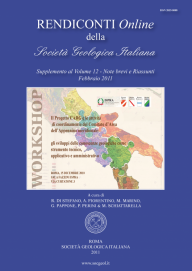
Il contributo della cartografia CARG "Gran Sasso d'Italia" nella definizione dell'assetto strutturale della catena centroappenninica
Fernando Calamita (*), Vittorio Scisciani (**), Mirko Di Vincenzo (***) & Alberto Pizzi (**)
(*) Dipartimento di Scienze della Terra, Università "G. D'Annunzio" di Chieti- Pescara, Viale Pindaro 42, 65127 Pescara, Italy.
(**) Dipartimento di Geotecnologie per l'Ambiente e il Territorio, Università "G. D'Annunzio" di Chieti-Pescara, Via dei Vestini 30, 66013 Chieti Scalo, Italy.
(***) Libero professionista, Regione Abruzzo.
DOI: https://doi.org/
Volume: 12/2011
Pages: 13-17
Abstract
The CARG Project in the "Gran Sasso d'Italia": a contribution to the definition of the structural setting of the Central Apennines.
The CARG geological survey project carried out in the Gran Sasso d'Italia area (Central Apennines) provided a new significant geological and structural dataset. The Gran Sasso mountain front represents a spectacular evidence of a Neogene fold and thrust system with a peculiar salient geometry that mimes the Mesozoic Adria paleomargin architecture. It is made up of Mesozoic Lazio-Abruzzi carbonate platform/margin succession, to the south, passing northward into slope succession at the transition with the Umbria-Marche Basin. The salient thrust front is delimited by two main segment approximately trending EW and N-S, located in the northern and eastern sector of the Gran Sasso thrust system, respectively. Only N-S striking contractional structures, instead, are found in the lower Laga Unit (e.g., the Montagnone anticline).
The E-W oriented Gran Sasso thrust front is characterized by two main en-echelon structures (i.e., the Monte S. Franco-Monte Jenca and the Monte Corvo-Monte Brancastello thrust fronts). The Monte S. Franco-Monte Jenca thrust is located in the western sector of the study area. In the central-eastern sector, the Monte Corvo-Monte Brancastello thrust front, composed by two main thrust planes, realizes the maximum amount of shortening along the apical zone of the salient. Shortening dies out westward into the Monte Corvo anticline.
Several Mesozoic pre-thrusting normal faults have been passively rotated during folding and they now appear as low-angle S/SW dipping normal faults and high-angle S/SW dipping reverse faults. Some of the pre-thrusting normal faults have also been reactivated during the Quaternary extensional tectonics and represent the intramontane basins border faults.
The new geological survey of the 349 sheet "Gran Sasso" allowed us to recognize crustal thrusts with their arcuate geometry controlled by pre-existing normal faults associated to the Adria paleomargin. This thick-skinned tectonic style is compatible with the prominent structural elevation in this sector of the chain as well as its reduced amount of shortening.
Keywords
Get Full Text